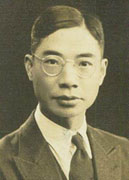The founder of Chinese modern bridge engineering: Mao Yisheng

|
Born: January 9, 1896 Died: November 12, 1989 Occupation: Bridge expert Political Party: Communist Party of China (Joined in 1987)
|
Mao Yisheng, male, Han nationality, was born in Zhenjiang, Jiangsu Province. He was a famous bridge expert, civil engineering scientist and educator of China.
Mao graduated from Tangshan Engineering College in 1916. He got his Master's degree of civil engineering from Cornell University in 1917 and earned the first PhD ever granted by the Carnegie Institute of Technology (now Carnegie Mellon University) in 1921, with his doctoral treatise entitled Secondary Stress on Frame Construction.
Mao's long and productive career included designing two of the most famous modern bridges in China, the Qiantang River Bridge near Hangzhou, and the Yangtze River Bridge at Wuhan. He also led the structural design of the Great Hall of the People in Beijing.
Returning to China, Mao was on the faculty of five major universities and served as president of four, such as the President and professor of Tangshan Engineering School of the Jiaotong University (now Southwest Jiaotong University), Director of Engineering Course of Southeast University, President of Engineering Course College of Beiyang University, Director of Project Office of Hangzhou Qiantangjiang Bridge, and Director of Bridge Planning Project Office of Transportation Ministry of Kuomintang Administration. He significantly influenced Chinese engineering education by introducing new subject matter and innovative pedagogical approaches. In addition to his engineering expertise, he was a distinguished scholar of the history of science in China.
Mao served as a leader of the China Engineers Association, the Chinese Civil Engineering Society and the China Association of Science and Technology. He has also served as president of Southwest Jiaotong University (from Tangshan Engineering College to Northern Jiaotong University to Southwest Jiaotong University), director of Railway Institute under the Ministry of Railway, president of Railway Scientific Research Center, chairman of Beijing Science Association, honorary president and vice-president of the China Association for Science and Technology, vice-chairman of Jiu San Society, vice-chairman of the Chinese People's Political Consultative Conference (CPPCC), member of CPPCC and the standing committee member of National People's Congress.
Mao was a senior member of International Bridge and Structural Project Association, and won the honorary title of Foreign Academician issued by the National Academy of Sciences in the United States.
Mao was regarded as the founder of modern bridge engineering. The Qiantangjiang Bridge designed with his guidance is the first dual-purpose road-and-railway bridge designed and built by the Chinese themselves. He also participated in the construction of China's first modern bridge -- Wuhan Yangtze River Bridge. During the construction of Wuhan Yangtze River Bridge, Mao Yisheng served as chairman of the Technical Advisory Committee composed of more than 20 foreign and Chinese bridge experts, and solved 14 difficult problems relating to bridge construction.
He advocated popular science education, and wrote "On Bridge", "China's Arch Bridges" and many other popular science articles.
In 1979, he was recognized as one of the "Notable Alumni" of Carnegie Mellon University for his outstanding contributions to civil engineering. In 1982, he won the title of Foreign Academician issued by the US National Academy of Sciences. In 1984, he became an honorary member of the Canadian Society for Civil Engineering.
Mao joined the Communist Party of China in October 1987.
He died of illness on November 12, 1989. On April 18, 2006, Carnegie Mellon University set up a statue honoring its first doctoral graduate. The sculpture includes an inscription from China's Premier, Wen Jiabao.
- Eight missing after cargo ship collides with fishing vessel near Shandong
- Investing in people: a worthwhile investment
- Exhibition commemorating the epic relocation of universities opens in Fujian
- Twelve punished for scaffold collapse that killed 7 in Shandong
- Slovenian official visits whole-process people's democracy practice site of CPPCC committees
- China's commercial rocket maker puts two satellites into orbit






































